Menus
- Top super sports cars from BMW, Kawasaki and MV Agusta
- Racetrack Ledenon
- Electronic driver assistants, power delivery
- Undercarriages
- Braking systems
- PS rating / judgment
- Technical data BMW HP4
- Technical data Kawasaki ZX-10R
- Technical data MV Agusta F4 RR

Jahn
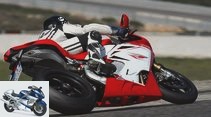


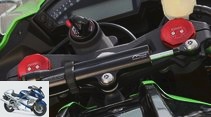
23 photos
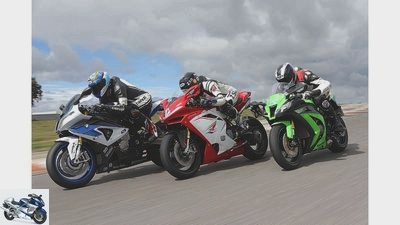
Jahn
1/23
BMW HP4 against MV Agusta F4 RR and Kawasaki ZX-10R.
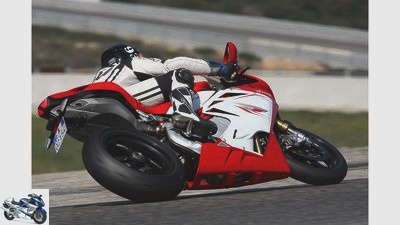
Jahn
2/23
MV Agusta F4 RR – lap time: 1.30.854 min (+ 0.709 sec).
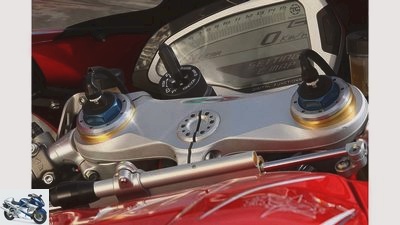
Jahn
3/23
The MV Agusta F4 RR also follows the trend of electronically adjustable chassis.
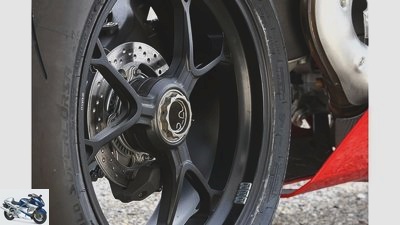
Jahn
4/23
The new bikes are stylish and extremely light.
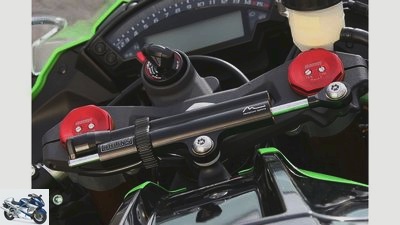
Jahn
5/23
For 2013, the Greens donated an electronic steering damper to their superbike.
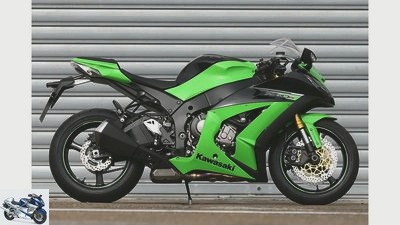
Jahn
6/23
Kawasaki ZX-10R.
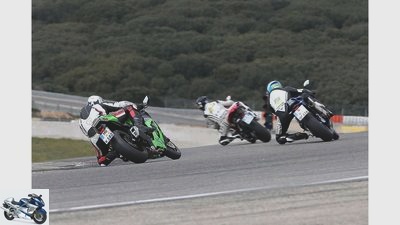
Jahn
7/23
Kawasaki ZX-10R, BMW HP4 and MV Agusta F4 RR.
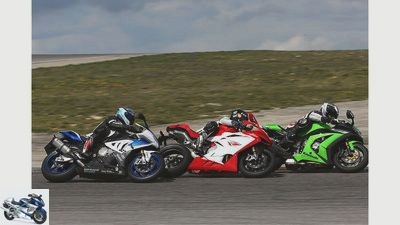
Jahn
8/23
BMW HP4, MV Agusta F4 RR and Kawasaki ZX-10R.
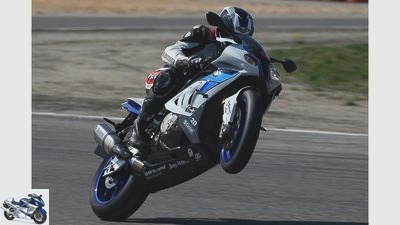
Jahn
9/23
BMW HP4 – lap time: 1.30.145 min (best time).
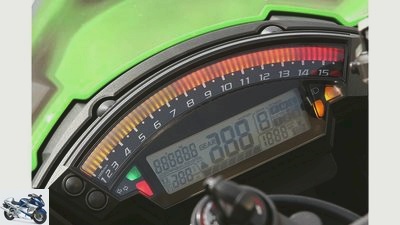
Jahn
10/23
Everything is so colorful here: display of the tens.
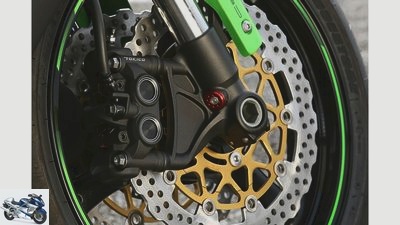
Jahn
11/23
Despite the rubber brake hoses, the stoppers of the ZX-10R are very stable. The spring preload can be changed with the red anodized adjuster on the fork base.
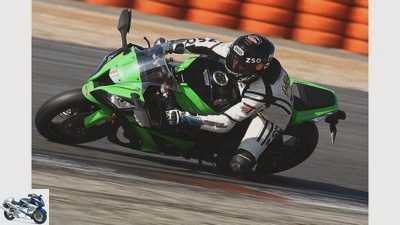
Jahn
12/23
Kawasaki ZX-10R – lap time: 1.30.433 min (+0.288 sec).
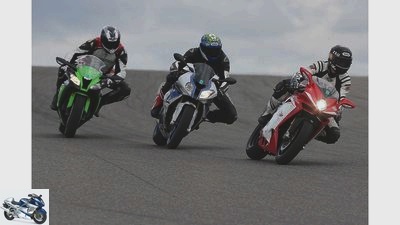
Jahn
13/23
Kawasaki ZX-10R, BMW HP4 and MV Agusta F4 RR.
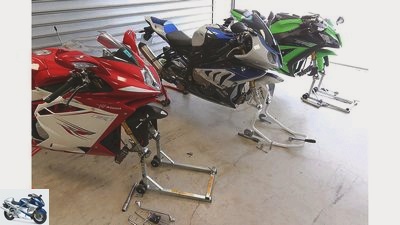
Jahn
14/23
MV Agusta F4 RR, BMW HP4 and Kawasaki ZX-10R.
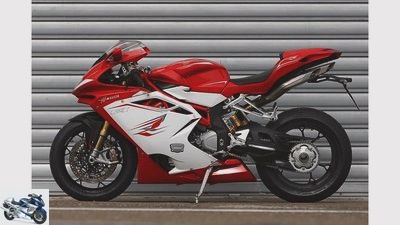
Jahn
15/23
MV Agusta F4 RR.
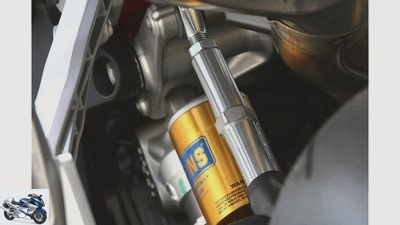
Jahn
16/23
The RR offers many adjustment options for the geometry. For example the push rod at the rear.
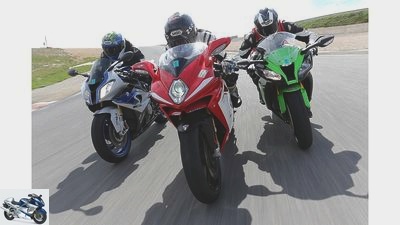
Jahn
17/23
BMW HP4, MV Agusta F4 RR and Kawasaki ZX-10R.
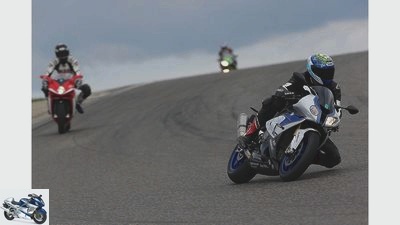
Jahn
18/23
BMW HP4 at the top.
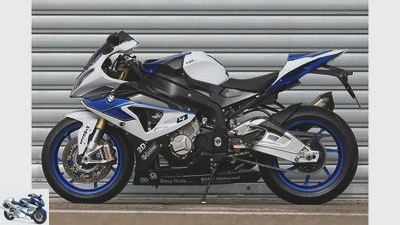
Jahn
19/23
BMW HP4.
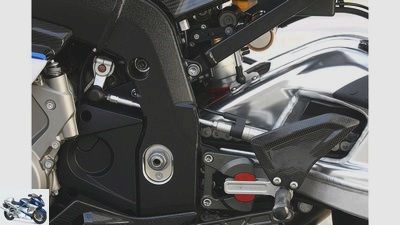
Jahn
20/23
The automatic switch works very smoothly. Above: upper linkage of the shock absorber including spring travel sensor.
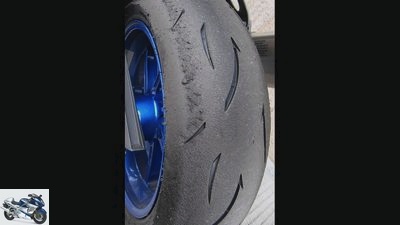
Jahn
21/23
The tire wear of the BMW is the highest of the trio.
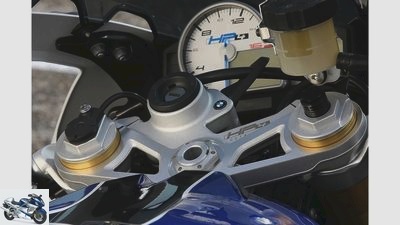
Jahn
22/23
Left damping, right preload: fork of the HP4.
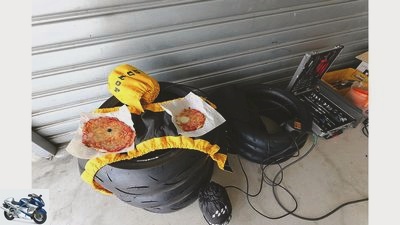
Jahn
23/23
Necessity makes you inventive: no more cold pizza thanks to tire warmers.
BMW HP4, Kawasaki ZX-10R, MV Agusta F4 RR
Top super sports cars from BMW, Kawasaki and MV Agusta
Content of
In terms of electronics and chassis, MV Agusta has significantly modernized its top model F4 RR. Is that enough to stir up the BMW HP4 and the Kawasaki ZX-10R?
Racetrack Ledenon
She drives at full throttle M.V Agusta F4 RR through the long uphill left curve before the start / finish on the southern French slope of Ledenon. The noticeable interventions in the engine management show that the traction control, unlike earlier models, finally works. More about the traction control of the MV Agusta F4 RR in a moment.
Buy complete article
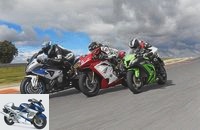
BMW HP4, Kawasaki ZX-10R, MV Agusta F4 RR
Top super sports cars from BMW, Kawasaki and MV Agusta
HP4 and the Japanese burner Kawasaki ZX-10R, which is equipped with plenty of driving aids, the top model of the F4 series challenges two tough opponents.
For this comparison, the former World Cup and IDM pilot Christian “Kelle” Kellner pulls on the cable. He beats the bikes for the demanding course, for which the incorruptible timekeeping system spits out the lap times. Results? Later! The brand new Dunlop D212 GP Pro is used as the standard tire for this test. Details about the rubber can be found on page 8. The organizer of the race training is Art Motor, who ensures that everything runs smoothly and bravely endures the fact that our guest tester feasts on his coffee …
Back to the traction control of the MV Agusta F4 RR. It works, but regulates somewhat roughly and the system sometimes raises questions. “On the short connecting piece after the steep downhill section and the uphill-right, it brutally stops the drive,” Kelle wonders.
Why the MV Agusta F4 RR does this remains their secret. Because here there is no significant inclination, nor does the electronics have to tame a rising front. At this point, the traction control regulates itself at level 1, which allows the most slip, and full thrust is only available when the system is deactivated.
Electronic driver assistants, power delivery
Jahn
MV Agusta F4 RR – lap time: 1: 30.854 min (+ 0.709 sec).
That’s what the BMW S 1000 RR does better. Neither here nor on other sections of the route does the DTC (Dynamic Traction Control) regulate unnecessarily. And if it intervenes, it makes it extremely inconspicuous. Only in the sharpest driving mode “Slick” does the traction control allow the pilot to make adjustments. The range is from +7 (early regulation) to -7 (late intervention). The whole thing works very easily even while driving using the rocker switch on the handlebars. “When the traction control is working, it feels like a rubber band that sometimes lets you off the leash more, sometimes less,” says Kelle happily. “The difference between +7 and -7 is not very big. And even with maximum slip, the system reliably catches the rear wheel. “
And the Kawasaki ZX-10R? It also regulates inconspicuously, gently and reliably. In contrast to earlier test machines, the second of three levels is now sufficient for even daring throttle acrobats. The importer only mentions the electronic steering damper as the only change for 2013. The plant in Japan may now and then retune the systems without communicating. It doesn’t matter, hobbyists feel their way from three to two in the dry. At the latest when the warning lamp flashes nervously in the “Race” mode of the HP4 and the traction control noticeably slows the Bavarian woman down, it is time for the slick mode and DTC level zero. And for the MV Agusta F4 RR, we recommend position 3 or 4 to start with.
Driving aids are not the only things that are easy on the nerves of nerves as you spin around with 200 hp hammers. A linear performance curve also contributes to this. In this discipline, the MV Agusta F4 RR also leaves springs. Up to 9000 rpm, the in-line quad develops its power evenly and, in contrast to the presentation (PS 3/2013), the throttle response is calculable. But from this mark onwards, the MV Agusta F4 RR no longer increases its power until it suddenly seems to explode at around 10,500 rpm. “It feels like a turbo is kicking in,” analyzes Kellner. “Especially when accelerating out of corners, it takes a lot of concentration to control the lightning-fast increase in power.”
In addition, the engine runs rough as usual, vibrates heavily and the gear changes are also quite resinous. The automatic gearshift offers a smart feature for this purpose: it also works when downshifting, with the engine even double-declutching. This allows the pilot to concentrate fully on braking and the line. At the presentation, the author was enthusiastic about this clever technology of the MV Agusta F4 RR, but it didn’t work on the test bike!
Kawasaki ZX-10R pilots still have to use the clutch when shifting up and down, because the Kawasaki ZX-10R is the only one of the trio that does not have a quickshifter. No wonder, after all, the Kawasaki ZX-10R costs a few thousand less than the competition. The calls for their premium racers 20 500 euros (base price BMW HP4) and 24 290 euros (MV Agusta F4 RR).
For a comparatively slim 16,695 euros, the customer with the Kawasaki ZX-10R gets, among other things, a very powerful unit that develops its punch in a pleasantly linear manner. However, the Kawasaki ZX-10R does not really get out of the quark, especially from tight corners, because of its long gear ratio and the comparatively restrained acceleration at low and medium speeds. Where the MV Agusta F4 RR and BMW HP4 buffle through in second gear, the Kawasaki ZX-10R requires first gear. This means that the Kawasaki ZX-10R driver has to shift gears more often because the speed reserves are insufficient in some passages.
In addition, the Kawasaki ZX-10R jumps on the accelerator a little abruptly, especially after long periods of coasting with closed throttle valves. The bottom line is that the Kawasaki ZX-10R offers a much more coherent engine concept than the MV Agusta F4 RR, which makes it more manageable.
But the real boss in the ring is called BMW HP4. Power in all situations, short gear ratio, high speed reserves, excellent controllable punch, soft yet spontaneous throttle response: the HP4 developers have done a great job. At this point we address a few words to those complainers who like to accuse us of looking through BMW glasses. Dear people: Just read older PS issues. Just like today, it says what’s going on. With the difference that BMWs usually performed poorly back then. And then ride a Bavarian superbike extensively. Then you will feel for yourself what we are talking about!
Undercarriages
Jahn
Kawasaki ZX-10R – lap time: 1: 30.433 min (+0.288 sec).
Speaking of time and talking: the highest railway to talk about the chassis. Like the MV Agusta F4 RR, the BMW HP4 offers various riding modes that also access the damping of the electronically adjustable suspension elements. For the test we selected the sportiest levels “Slick” (BMW HP4) and “S” (MV Agusta F4 RR).
In these modes, the coordination of fork and shock absorber is most taut, but the systems also allow for harder or softer corrections. How this works exactly can be found in the instructions for use as thick as an arm. In contrast to the MV Agusta F4 RR, the BMW HP4 has a semi-active chassis that automatically adapts the damping to the different driving situations. As a basic setup, the factory settings of both bikes work so well that we didn’t push the switches any further.
The Kawasaki ZX-10R still requires tools when making setup changes. This is mainly used in the very softly tuned shock absorber to close the damping almost completely. Nevertheless, the monoshock causes a lot of restlessness when gasping. “When I go to the limit, the Kawasaki ZX-10R rocks up a lot,” says Kelle. “But these are not hard or jerky movements, rather it is reminiscent of a good-natured American sledge.”
The tendency towards wide arches, to which the Kawa tends in direct comparison, is more disturbing. It demands exact aiming at the desired line, and in curves it needs the greatest physical effort. This is at least partly due to the Dunlops, which apparently prefer a chassis balance trimmed for handling. On the plus side of the Kawasaki ZX-10R is the unshakable braking stability that has always characterized it.
Braking systems
Jahn
BMW HP4 – lap time: 1: 30.145 min (best time).
The MV represents the complete opposite of this. Her stern often breaks out when anchoring, which in the long run only pleases wild braking drifters. These artists are also most likely to get over the lack of ABS. In return, the RR angles very easily and precisely, stays safely on the line, is extremely stable in an inclined position and provides crystal-clear feedback from the road – amazing! Alone the seating position, which takes getting used to, with the high seat and the relatively far forward and deeply mounted handlebar stubs, tarnishes the picture a bit and is exhausting in the long run.
On the Kawasaki ZX-10R and the BMW S 1000 RR, the rider sits a lot more comfortably and at least as actively. In addition, the HP4 shoots a tad more manageable through the corners than the MV Agusta F4 RR, is similarly stable and it also tells the driver exactly what the tarmac has to offer.
Filing times is clearly easiest on the BMW HP4, which brings us to the topic: With 1: 30.145 minutes, the ZX-10R burns it for almost three tenths of a second (1: 30.433 min), but feels much faster. And the MV Agusta F4 RR? With 1: 30.854 minutes, he is seven tenths of a second behind the BMW HP4 and a good four tenths behind the Kawasaki ZX-10R. In addition, it requires the most familiarization, filing is the most strenuous with it and it requires the most concentration. Not only in the long uphill left curve before the start / finish in Ledenon.
PS rating / judgment
Jahn
Kawasaki ZX-10R, BMW HP4 and MV Agusta F4 RR.
| Max. Points | BMW HP4 |
Kawasaki ZX-10R | MV Agusta F4 RR |
drive |
| acceleration | 10 | 9 | 9 | 9 | Draft | 10 | 8th | 7th | 7th |
| Power delivery | 10 | 10 | 7th | 5 | Responsiveness | 10 | 9 | 9 | 7th |
| Load change reaction | 10 | 8th | 8th | 8th | Running culture | 10 | 8th | 7th | 6th |
| Gear actuation | 10 | 9 | 8th | 7th | Gear ratio | 10 | 9 | 7th | 8th |
| Clutch function | 10 | 9 | 9 | 8th | Traction control | 10 | 10 | 8th | 6th |
| Subtotal | 100 | 89 | 79 | 71 | landing gear |
| Driving stability | 10 | 9 | 8th | 8th | Handiness | 10 | 9 | 7th | 8th |
| Cornering stability | 10 | 9 | 8th | 10 | feedback | 10 | 9 | 8th | 10 |
| Suspension tuning in front | 10 | 9 | 9 | 9 | Chassis set-up at the rear | 10 | 9 | 7th | 9 |
| Braking effect | 10 | 9 | 9 | 9 | Brake metering | 10 | 9 | 9 | 9 |
| Installation moment at | Brakes | 10 | 9 | 9 | 9 |
| ABS function | 10 | 10 | 9 | – | Subtotal | 100 | 91 | 83 | 81 |
| Everyday life and driving fun | Sitting position | 10 | 9 | 9 | 6th |
| Windbreak | 10 | 7th | 8th | 6th | Furnishing | 10 | 9 | 8th | 8th |
| consumption | 10 | – | – | – | Driving fun | 10 | 10 | 8th | 6th |
| Subtotal | 50 | 35 | 33 | 26th | Total | 250 | 215 | 195 | 178 |
| placement | 1. | 2. | 3. |
Jahn
BMW HP4 at the top.
PS judgment
1. BMW HP4
The competition is grappling with the BMW. It’s almost shocking how perfectly the Munich woman works. Who would have thought ten years ago that Bavaria would one day construct such a weapon? None!
2. Kawasaki ZX-10R
The good-natured Zenner lands in second place. Your electronic driving aids work great. Biggest weaknesses: underdamped shock absorber and the power delivery in combination with the long first gear.
3rd MV Agusta F4 RR
The F4 are definitely better suited to flowing routes with long radii. But even there, features such as a steady performance curve and proper traction control count. And there it still has deficits.
Technical data BMW HP4
Jahn
BMW HP4.
drive
Four-cylinder in-line engine, four valves / cylinder, 142 kW (193 hp) at 13,000 rpm *, 112 Nm at 9750 rpm *, 999 cm³, bore / stroke: 80.0 / 49.7 mm, compression ratio: 13, 0: 1, ignition / injection system, 48 mm throttle valves, mechanically operated multi-disc oil bath anti-hopping clutch, six-speed gearbox, G-Kat, chain, traction control
landing gear
Light alloy bridge frame, steering head angle: 66.0 degrees, caster: 98.5 mm, wheelbase: 1423 mm, upside-down fork, Ø fork inner tube: 46 mm, adjustable in spring base, automatic adjustment of rebound and compression. Central spring strut with deflection, adjustable in the spring base, automatic adjustment of rebound and compression. Suspension travel front / rear: 120/130 mm
Wheels and brakes
Forged light alloy wheels, 3.50 x 17 / 6.00 x 17, front tires: 120/70 ZR 17, rear: 200/55 ZR 17, test tires: Dunlop D212 GP Pro, 320 mm double disc brakes with four-piston fixed calipers at the front, 220 mm -Single disc with single-piston floating caliper at the rear, ABS
measurements and weight
Length / width / height: 2080/785/1110 mm, seat / handlebar height: 805/860 mm, handlebar width: 660 mm, 201.5 kg with a full tank (without pillion package), v./h .: 52.5 / 47, 5%
Rear wheel power in last gear
137.5 kW (187 hp) at 271 km / h
consumption
Fuel type: Super unleaded. Average test consumption: k. A., tank capacity 17.5 liters, range: ns. A..
Base price
20,500 euros (plus additional costs), competition package: 3200 euros
Technical data Kawasaki ZX-10R
Jahn
Kawasaki ZX-10R.
drive
Four-cylinder in-line engine, four valves / cylinder, 147 kW (200 PS) at 13,000 / min *, 112 Nm at 11,500 / min *, 998 cm³, bore / stroke: 76.0 / 55.0 mm, compression ratio: 13 , 0: 1, ignition / injection system, 47 mm throttle valves, mechanically operated multi-disc oil bath anti-hopping clutch, six-speed gearbox, G-Kat, chain, traction control
landing gear
Light alloy bridge frame, steering head angle: 65.0 degrees, caster: 107 mm, wheelbase: 1425 mm, upside-down fork, Ø fork inner tube: 43 mm, adjustable spring base, rebound and compression level. Central spring strut with deflection, adjustable in spring base, rebound and compression (high / low). Suspension travel front / rear: 120/140 mm
Wheels and brakes
Cast light alloy wheels, 3.50 x 17 / 6.00 x 17, front tires: 120/70 ZR 17, rear: 190/55 ZR 17, test tires: Dunlop D212 GP Pro, 310 mm double disc brakes with four-piston fixed calipers at the front, 220 -mm single disc with single-piston floating caliper at the rear, ABS
measurements and weight
Length / width / height: 2130/900/1130 mm, seat / handlebar height: 810/850 mm, handlebar width: 655 mm, 203 kg fully fueled, v./h .: 51.7 / 48.3%
Rear wheel power in last gear
132.5 kW (180 PS) at 278 km / h
consumption
Fuel type: Super unleaded. Average test consumption: n / a, tank capacity 17.0 liters, range: n / a.
Base price
15 695 euros (plus additional costs), ABS: 1000 euros
Technical data MV Agusta F4 RR
Jahn
MV Agusta F4 RR.
drive
Four-cylinder in-line engine, four valves / cylinder, 148 kW (201 HP) at 13,600 / min *, 111 Nm at 9600 / min *, 998 cm³, bore / stroke: 79.0 / 50.9 mm, compression ratio: 13, 4: 1, ignition / injection system, 49 mm throttle valves, hydraulically operated multi-disc oil bath anti-hopping clutch, six-speed gearbox, G-Kat, chain, traction control
landing gear
Steel tubular space frame, steering head angle: 66.5 degrees, caster: 100 mm, wheelbase: 1430 mm, upside-down fork, Ø fork inner tube: 43 mm, adjustable in spring base, rebound and compression. Central spring strut with deflection, adjustable in spring base, rebound and compression. Suspension travel front / rear: 120/120 mm
Wheels and brakes
Forged light alloy wheels, 3.50 x 17 / 6.00 x 17, front tires: 120/70 ZR 17, rear: 200/55 ZR 17, test tires: Dunlop D212 GP Pro, 320 mm double disc brakes with four-piston fixed calipers at the front, 210 -mm single disc with four-piston fixed caliper at the rear
measurements and weight
Length / width / height: 2115/750/1090 mm, seat / handlebar height: 840/845 mm, handlebar width: 710 mm, 212 kg fully fueled, v./h .: 52.1 / 47.9%
Rear wheel power in last gear
130 kW (177 PS) at 282 km / h
consumption
Fuel type: Super unleaded. Average test consumption: n / a, tank capacity 17 liters, range: n / a.
Base price
24 290 euros (plus additional costs)
Related articles
-
Comparison test: super sports cars under 1000 cubic meters from MV Agusta, Ducati and Kawasaki
Jahn 46 pictures Jahn 1/46 Kawasaki ZX-6R 636 Jahn 2/46 But the Evo is not alone in this. All three bikes rock the ring during the test. Jahn 3/46 ……
-
BMW F 800 R, Kawasaki Z 800, MV Agusta Brutale 800 and Yamaha FZ8 in the test
Jahn 29 pictures Jahn 1/29 A comparison of four 800 class motorcycles: BMW F 800 R, Kawasaki Z 800, MV Agusta Brutale 800 and Yamaha FZ8. Jahn 2/29 How …
-
Superbikes put to the test: BMW S 1000 RR, Kawasaki ZX -10 R and MV Agusta F4 RR
fact 18th photos fact 1/18 What counts on the road is all the more important on the Nordschleife: a swelling torque curve and an uncomplicated,…
-
Kawasaki Ninja ZX-10R – old versus new compared
fact 24 pictures www.factstudio.de 1/24 Kawasaki ZX-10R: old versus new. www.factstudio.de 2/24 Kawasaki ZX-10R 2016: Brembo instead of Tokico, “balance free” …
-
Top test: Kawasaki ZX-10R old-new
Top test: Kawasaki ZX-10R old / new The double top test of the old and new 10-ninja The ZX-10R has never lacked power. But now …
-
Kawasaki ZX-10R and BMW S 1000 RR in a comparison test
www.bilski-fotografie.de 25 pictures www.bilski-fotografie.de 1/25 Let’s first take a look at the new Kawasaki ZX-10R. www.bilski-fotografie.de …
-
New Kawasaki Ninja ZX-10R (2016) in the driving report
Kawasaki 18 pictures Kawasaki 1/18 Kawasaki Ninja ZX-10R. Kawasaki 2/18 Kawasaki Ninja ZX-10R. Kawasaki 3/18 Kawasaki Ninja ZX-10R. Kawasaki 4/18 Kawasaki …
-
BMW R 1200 R, Kawasaki Z 800, MV Agusta Brutale 800 RR and KTM 1290 Super Duke R in the test
markus-jahn.com 35 pictures markus-jahn.com 1/35 BMW R 1200 R, MV Agusta Brutale 800 RR, Kawasaki Z 800 and KTM 1290 Super Duke R – It’s a shame that …
-
Endurance test final balance of the Kawasaki ZX-10R
Bilski endurance test final balance sheet Kawasaki ZX-10R Too good to strip After 50,000 kilometers it is opened, looked inside and measured. So are the …
-
Comparison test BMW S 1000 RR, Kawasaki ZX-10R and Yamaha YZF-R1M
22 images 1/22 BMW S 1000 RR, Kawasaki Ninja ZX-10R and Yamaha YZF-R1M. 2/22 Yamaha YZF-R1M. 3/22 BMW …